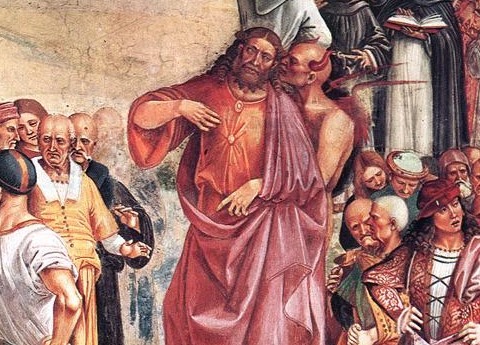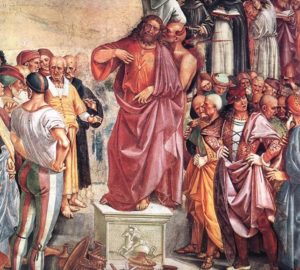There is much lore about the antichrist (especially among certain Evangelicals) that is out of proportion to the attention Scripture pays to the concept, and more importantly is at possible variance from what is certainly taught. It easily becomes fodder for movies and novels: the antichrist figure steps on the scene, deceiving many, and mesmerizing the whole world with apparent miracles and a message of false peace.
But is this really what or whom the Scriptures call the antichrist? I would argue not, for in order to create such a picture one would have to splice in images from the Book of Revelation and the Letter to the Thessalonians that do not likely apply to antichrists.
In fact, the use of the term antichrist occurs only in the Johannine epistles. It does not occur in the Book of Revelation at all, though many have the mistaken idea that it does. There are plenty of beasts, dragons, harlots, demons, and satanic legions in Revelation, but no mention of antichrists.
Many also stitch the teaching about antichrists together with St. Paul’s teaching on the “man of lawlessness” (also called “the lawless one”) who is to appear just before the end. The lawless one may well be the stuff of movies, but calling him the antichrist may be to borrow too much from a concept that is more specific. While it is not inauthentic to make a connection between them (some of the Church Fathers seem to), it is not necessarily correct to do so.
In this reflection I take the position that it is improbable that the antichrist and the man of lawlessness are one and the same. In order to explain why, let’s first look at the occurrences of the term antichrist in St. John’s Epistles.
-
- Little children, it is the last hour: and as you have heard that antichrist shall come, even now are there many antichrists; whereby we know that it is the last time (1 John 2:18).
- Who is the liar but the one who denies that Jesus is the Christ? This is the antichrist, the one who denies the Father and the Son (1 John 2:22).
- By this you know the Spirit of God: every spirit that confesses that Jesus Christ has come in the flesh is from God, and every spirit that does not confess Jesus is not from God. And this is the spirit of the antichrist, of which you have heard that it is coming; and now it is already in the world (1 John 4:2–3).
- Many deceivers have gone out into the world, those who do not confess that Jesus Christ has come in the flesh; any such person is the deceiver and the antichrist! (2 John 1:7)
Note two things about antichrists. First, St. John (writing in the first century) teaches that he has already appeared. In calling this the “last hour,” St. John and the Holy Spirit do not mean that the Second Coming will take place in the next sixty minutes or even in the next few years. Rather, the teaching is that we are in the Last Age, the Age of the Messiah (also called the Age of the Church), when God is sending out His angels to the four winds to gather all the elect from the ends of the earth (cf Mark 4:21). Sadly, St. John also teaches that the antichrist has already come as well.
Second, after saying that the antichrist has come, St. John immediately clarifies by saying that actually many antichrists have appeared.
Thus St. John does not seem to present the antichrist as a single figure who has come. Rather, he says that there are many antichrists.
And what do these antichrists do? They perpetrate heresy, error, and false teaching. St. John notes in particular that heretics who deny that Jesus is the Christ (the Messiah) are antichrists. He also calls antichrists those who deny Christ having come in the flesh.
What does it mean to deny Christ having come in the flesh? It means reducing the saving work of God to mere appearances by claiming that Jesus did not actually take up a human nature but only appeared to do so. By extension, these same antichrists reduce the Christian moral and spiritual life to mere gnostic ideas rather than a true flesh-and-blood, body-and-soul change in our lives.
Many today extend these denials of the incarnation by undermining the historic authenticity of the Gospels, doubting or outright denying what Jesus actually said and did. Some of them say that Jesus’ resurrection was not a bodily one, but rather that His “ideas live on.” There can be no more fundamental heresy that to deny the bodily resurrection of Christ. As St. Paul says, And if Christ has not been raised, then our preaching is in vain and your faith is in vain … if Christ has not been raised, your faith is futile and you are still in your sins … [and] we are of all people most to be pitied (1 Cor 15:14-17).
Thus St. John, along with all the early Church, emphatically upholds an incarnational faith. We could actually touch our God and He touched us by taking up our human nature. He suffered on the cross and died. And though His suffering was tied to His human nature (for His divine nature is impassible), Jesus, the Second Person of the Blessed Trinity, hypostatically united to His human nature, suffered and died for us. It was this same human nature that God raised from the dead, gloriously transformed.
John takes up this theme elsewhere when he says that Christ came in water and in blood, not in water alone (cf 1 John 5:6). A certain heretic of that time, Cerinthus, held that the Second Person of the Blessed Trinity departed just before Jesus’ passion. John refutes this, insisting that just as at His baptism Jesus’ divine nature was affirmed (This is my beloved Son in whom I am well pleased), so also was it affirmed during the shedding of His blood on Calvary (the inspired word of God records the centurion, on seeing the manner of Jesus’ death, saying, Surely this was the Son of God (Mat 27:54)). Jesus Christ, the Son of God, though of two natures, is one person, and He did in fact die suffer and die for us.
Thus to St. John, the essence of the antichrist is denial that Jesus came in the flesh. An antichrist is one who would relegate Jesus’ presence among us to mere appearances or His teachings to mere abstractions or ideals rather than transformative realities.
By extension, it can be argued that the term antichrist refers to all deceivers, though only logically, not specifically in the text. St. John does not indicate that he means the term antichrist this broadly, but in a wider sense all heresy pertains to the antichrist because Jesus Christ is the truth. Jesus teaches through His apostles that to deny the truth is to deny Christ Himself; it is to deny truth itself and thus to be an antichrist.
So perhaps this is not fodder for movies and novels after all; sorry! And that’s a shame because the term antichrist is so catchy! This brings us to a discussion of the man of lawlessness (or the lawless one).
What or who is the man of lawlessness whom St. Paul mentions and how is he related to the antichrist? As I stated above, I do not think there is a connection. To see why, let’s consider what St. Paul teaches:
-
- As to the coming of our Lord Jesus Christ and our being gathered together to him, we beg you, brothers and sisters, not to be quickly shaken in mind or alarmed, either by spirit or by word or by letter, as though from us, to the effect that the day of the Lord is already here. Let no one deceive you in any way; for that day will not come unless the rebellion comes first and the Man of lawlessness is revealed, the one destined for destruction. He opposes and exalts himself above every so-called god or object of worship, so that he takes his seat in the temple of God, declaring himself to be God (2 Thessalonians 2:1–4).
- For the mystery of lawlessness is already at work, but only until the one who now restrains it is removed. And then the lawless one will be revealed, whom the Lord Jesus will destroy with the breath of his mouth, annihilating him by the manifestation of his coming. The coming of the lawless one is apparent in the working of Satan, who uses all power, signs, lying wonders, and every kind of wicked deception for those who are perishing, because they refused to love the truth and so be saved (2 Thessalonians 2:7–10).
Note the following crucial differences between antichrists and the lawless one:
- John speaks of antichrists in the plural whereas St. Paul speaks in the singular: the man of lawlessness or the lawless one.
- The lawless one’s deceptions are rather general (every kind of wicked deception), whereas deceptions of antichrists are more specifically related to denying the incarnation of the Son of God.
Jesus also speaks of those who will lead many astray, though He speaks of them in the plural and is likely referring to occurrences in the first century during the time leading up to the war with the Romans in 70 A.D: For false messiahs and false prophets will appear and produce great signs and wonders, to lead astray, if possible, even the elect (Matthew 24:24).
As you can see, there are a lot of moving parts here as well as a lot of singulars and plurals to sort out and time frames to consider. Permit me the following conclusions:
- Antichrist is a more restrictive term than most people today think. While the antichrist is not a single person but rather any number of persons, the concept of antichrists seems limited to those who deny that Jesus is the Christ, come in the flesh. However, the term can possibly be applied to heretics in general.
- Jesus warns of false prophets and messiahs, but the context of His warning seems to be the first century and the looming destruction of Jerusalem not the end times per se. Further, He speak of many false prophets, not a single one.
- It is the man of lawlessness spoken of by St. Paul that most fits the charismatic figure of our “movie script,” a person able to unite the world in a false peace by mesmerizing and deceiving the nations. This lawless one will signal the end times. While I am not saying that these are the end times, I will note that the advent of instant, worldwide communication has made things easier than ever before for the lawless one. One individual actually could mesmerize and deceive all the nations—right on the worldwide web!
All that said, I believe that equating this lawless one with one of the beasts of Revelation or with the antichrist may be too speculative, and possibly inaccurate.
I hope I haven’t toyed with your “movie script” too much, but Scripture is nuanced in these matters and we do well to avoid reducing its teachings to popular concepts and catchy notions.
Scripture does speak to us of the end times and of difficult times preceding them, but the information is often given in general, even cryptic, terms. It is as if Scripture wants to tell us to be ready and to let us know that we don’t need to (and shouldn’t want to) know all the details. Just be ready, and when those times set in remember that Christ has already won the battle. Viva Christo Rey!
Cross-posted at the Catholic Standard: Who or What Is the Antichrist? A Reflection on the Biblical Teaching



